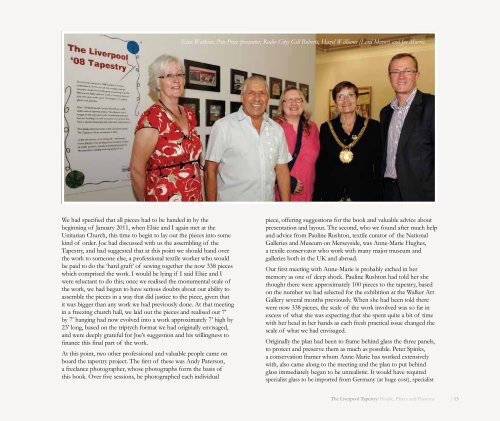Gill Roberts - The Liverpool 08 Tapestry
Gill Roberts - The Liverpool 08 Tapestry
Gill Roberts - The Liverpool 08 Tapestry
You also want an ePaper? Increase the reach of your titles
YUMPU automatically turns print PDFs into web optimized ePapers that Google loves.
We had specified that all pieces had to be handed in by the<br />
beginning of January 2011, when Elsie and I again met at the<br />
Unitarian Church, this time to begin to lay out the pieces into some<br />
kind of order. Joe had discussed with us the assembling of the<br />
<strong>Tapestry</strong>, and had suggested that at this point we should hand over<br />
the work to someone else, a professional textile worker who would<br />
be paid to do the ‘hard graft’ of sewing together the now 338 pieces<br />
which comprised the work. I would be lying if I said Elsie and I<br />
were reluctant to do this; once we realised the monumental scale of<br />
the work, we had begun to have serious doubts about our ability to<br />
assemble the pieces in a way that did justice to the piece, given that<br />
it was bigger than any work we had previously done. At that meeting<br />
in a freezing church hall, we laid out the pieces and realised our 7’<br />
by 7’ hanging had now evolved into a work approximately 7’ high by<br />
23’ long, based on the triptych format we had originally envisaged,<br />
and were deeply grateful for Joe’s suggestion and his willingness to<br />
finance this final part of the work.<br />
At this point, two other professional and valuable people came on<br />
board the tapestry project. <strong>The</strong> first of these was Andy Paterson,<br />
a freelance photographer, whose photographs form the basis of<br />
this book. Over five sessions, he photographed each individual<br />
Elsie Watkins, Pete Price (presenter, Radio City) <strong>Gill</strong> <strong>Roberts</strong>, Hazel Williams (Lord Mayor) and Joe Morris.<br />
piece, offering suggestions for the book and valuable advice about<br />
presentation and layout. <strong>The</strong> second, who we found after much help<br />
and advice from Pauline Rushton, textile curator of the National<br />
Galleries and Museum on Merseyside, was Anne-Marie Hughes,<br />
a textile conservator who work with many major museum and<br />
galleries both in the UK and abroad.<br />
Our first meeting with Anne-Marie is probably etched in her<br />
memory as one of deep shock. Pauline Rushton had told her she<br />
thought there were approximately 100 pieces to the tapestry, based<br />
on the number we had selected for the exhibition at the Walker Art<br />
Gallery several months previously. When she had been told there<br />
were now 338 pieces, the scale of the work involved was so far in<br />
excess of what she was expecting that she spent quite a bit of time<br />
with her head in her hands as each fresh practical issue changed the<br />
scale of what we had envisaged.<br />
Originally the plan had been to frame behind glass the three panels,<br />
to protect and preserve them as much as possible. Peter Spinks,<br />
a conservation framer whom Anne-Marie has worked extensively<br />
with, also came along to the meeting and the plan to put behind<br />
glass immediately began to be unrealistic. It would have required<br />
specialist glass to be imported from Germany (at huge cost), specialist<br />
<strong>The</strong> <strong>Liverpool</strong> <strong>Tapestry</strong>: People, Places and Passions | 13


